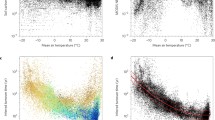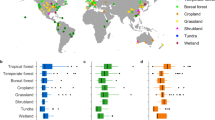Abstract
Results of a simple model of the effects of temperature on net ecosystem production call into question the argument that the large stocks of soil carbon and greater projected warming in the boreal and tu ndra regions of the world will
lead to rapid efflux of carbon from these biomes to the atmosphere. We show that low rates of carbon turnover in these regions and a relatively greater response of net primary production to changes in temperature may lead to carbon storage over some limited range of warming. In contrast, the high rates of soil respiration found in tropical ecosystems are highly sensitive to small changes in temperature, so that despite the less pronounced warming expected in equatorial regions, tropical soils are likely to release relatively large amounts of carbon to the atmosphere. Results for high-latitude biomes are highly sensitive to parameter values used, while the net efflux of carbon from the tropics appears robust.
Similar content being viewed by others
References
Aber, J. D., Melillo, J. M., McClaugherty, C. A., and Eshleman, K. N.: 1989, ‘Nitrogen Saturation in Northern Forest Ecosystems-Hypotheses and Implications’, Bioscience 39, 378–386.
Atjay, G. L., Ketner, P., and Duvigneaud, P.: 1979, ‘Terrestrial Primary Production and Phytomass’, in Bolin, B., Degens, E., Kempe, E, and Ketner, P. (eds.), The Global Carbon Cycle, SCOPE, 13, Wiley, Chichester, 129–182.
Berendse, F., Berg, B., and Bosatta, E.: 1987, ‘The Effect of Lignin, and Nitrogen on the Decomposition of Litter in Nutrient-Poor Ecosystems: A Theoretical Approach’, Can. J. Bot. 65, 1116–1120.
Berg, B.: 1984, ‘Decomposition of Root Litter and Some Factors Regulating the Process: Long-term Root Litter Decomposition in a Scots Pine Forest’, Soil Biol. Biochem. 16, 609–619.
Berg, B.: 1985, ‘Temporal Variation of Litter Decomposition in Relation to Simulated Soil Climate Long-term Decomposition in a Scots Pine Forest. V’. Can. J. Bot. 63, 1008–1016.
Bonan, G. B.: 1991, ‘Seasonal and Annual Carbon Fluxes in a Boreal Forest Landscape’, J. Geophys. Res. 96, 17329–17338.
Brown, S. and Lugo, A. E.: 1982, ‘The Storage and Production of Organic Matter in Tropical Forests and Their Role in the Global Carbon Cycle’, Biotropica 14, 161–187.
Cowling, J. E. and MacLean, Jr, S. F.: 1981, ‘Forest Floor Respiration in a Black Spruce Taiga Forest Ecosystem in Alaska’, Holarct. Ecol. 4, 229–237.
Fetter, A. H. and Hay, R. K. M.: 1981, Environmental Physiology of Plants, Academic Press, London.
Flanagan, P. W. and Van Cleve, K.: 1983, ‘Nutrient Cycling in Relation to Decomposition and Organic matter Quality in Taiga Ecosystems’, Can. J. For. Res. 13, 795–817.
Fung, I. Y, Tucker, C. Y, and Prentice, K. C.: 1987, ‘Application of Advanced Very High Resolution Radiometer Vegetation Index to Study of Atmosphere-Biosphere Exchange of CO2’, J. Geophys. Res. 92 (D3), 2999–3015.
Gates, D. M.: 1980, Biophysical Ecology, Springer-Verlag, New York.
Gordon, A. M., Schlentner, R. E., and Van Cleve, K.: 1987, ‘Seasonal Patterns of Soil Respiration and CO2 Evolution Following Harvesting in the White Spruce Forests of Interior Alaska’, Can. J. For. Res. 17, 304–310.
IGAC: 1990, Terrestrial Biosphere Exchange with Global Atmospheric Chemistry ..., IGBP report 13, Matson, P. A. and Ojima, D. S. (eds.), IGBP, Stockholm.
IPCC: 1990, Climate Change: The IPCC Scientific Assessment, Report of the Intergovernmental Panel on Climate Change, Cambridge University Press, Cambridge.
Kittel, T. G. F., Schimel, D. S., Parton, W. J., Ojima, D. S., and Hunt, H. W.: ‘Regional Consequences of Climate Change and Doubled CO2 on Nutrient Cycling and Primary Productivity of the U.S. Great Plains’, Nature, submitted.
Lieth, H.: 1975, ‘Modeling the Primary Productivity of the World’, in Lieth, H. and Whittaker, R. H. (eds.), Primary Productivity of the Biosphere, Springer Verlag, New York.
Marston, J. B., Oppenheimer, M., Fujita, R. M., Gaffin, S. R.: 1991, ‘Carbon Dioxide and Temperature’, Nature 349, 573–574.
Matson, P. A. and Vitousek, P. M.: 1990, ‘Ecosystem approaches for the Development of a Global Nitrous Oxide Budget’, Bioscience 40, 667–672.
Medina, E. and Zelwer, M.: 1972, ‘Soil Respiration in Tropical Plant Communities’, in Golley, P. M. and Golley, F. B. (eds.), Papers from a symposium on tropical ecology with an emphasis on organic productivity, Univ. of Georgia, Athens, pp.245–269.
Meentmeyer, V.: 1984, ‘The Geography of Organic Decomposition Rates’, Ann. Assoc. Amer. Geogr. 74, 551–560.
Mooney, H. A., Vitousek, P. M., and Matson, P. A.: 1987, ‘Exchange of Materials between Terrestrial Ecosystems and the Atmosphere’, Science 238, 926–932.
Parton, W. J., Schimel, D. S., Cole, C. V, and Ojima, D. S.: 1987, ‘Analysis of Factors Controlling Soils Organic Mailer Levels in the Great Plains Grasslands’, Soil Sci. Soc. Amer. J. 5l, 1173–1179.
Pastor, J. and Post, W. M.: 1986, ‘Influence of Climate, Soil Moisture, and Succession on Forest Carbon and Nitrogen Cycles’, Biogeochemistry 2, 3–27.
Post, W. M., Emanuel, W. R., Zinke, P. J., and Stangenberger, A. G.: 1982, ‘Soil Carbon Pools and World Life Zones’, Nature 298,156–159.
Prentice, K. C.: 1986, The Influence of the Terrestrial Biosphere on Seasonal Atmospheric Carbon Dioxide: An Empirical Model, Ph.D. thesis, Columbia University, New York City, New York.
Raich, J. W. and Nadelhoffer, K. J.: 1989, ‘Belowground Carbon Allocation in Forest Ecosystems’, Ecology 70, 1346–1354.
Raich, J. W. and Schlesinger, W. H.: ‘The Global Carbon Dioxide Flux in Soil Respiration and Its Relationship to Climate’, Tellus, in press.
Reiners, W. A.: 1968, ‘Carbon Dioxide Evolution from the Floor of Three Minnesota Foresls’, Ecology 49, 471–483.
Schimel, D. S.: 1986, ‘Carbon and Nitrogen Turnover in Adjacenl Grassland and Cropland Ecosystems’, Biogeochemistry 2, 345–357.
Schimel, D. S., Parton, W. J., Kittel, T. G. F., Ojima, D. S., and Cole, C. V: 1990, ‘Grassland Biogeochemistry: Links to Atmospheric Processes’, Clim. Change 17, 13–25.
Schlentner, R. E. and Van Cleve, K.: 1985, ‘Relationships Belween CO2 Evolution from Soil, Substrate Temperature, and Substrate Moisture in Four Forest Types in Interior Alaska’, Can. J. For. Res. 15, 97–106.
Schlesinger, W. H.: 1977, ‘Carbon Balance in Terrestrial Detritus’, Ann. Rev. Ecol. Syst. 8, 51–81.
Schlesinger, W. H.: 1991, Biogeochemistry: An Analysis of Global Change, Academic Press, San Diego.
Singh, J. S. and Gupta, S. R.: 1977, ‘Plant Decomposition and Soil Respiration in Terrestrial Ecosystems’, Botan. Rev. 43, 449–528.
Stewart, J. M. and Wheatley, R. E., 1990, ‘Estimates of CO2 Production from Eroding Peat Surfaces’, Soil Biol. Biochem. 22 (1), 65–68.
Svensson, B. H.: 1980, ‘Carbon Dioxide and Methane Fluxes from the Ombrotophic Paris of a Subarctic Mire’, Ecol. Bull. 30, 235–250.
Svensson, B. H. and Rosswall, T.: 1980, ‘Energy Flow through a Subarctic Mire at Stordalen’, in Sonesson, M. (ed.), Ecology of a Subarctic Mire Ecol. Bull. (Stockholm) 30, 282–301.
Trumbore, S. E., Bonani, G., and Wolfi, W.: 1990, ‘The Rates of Carbon Cycling in Several Soils from AMS 14C Measurements of Fractionated Soil Organic Matter’, in Bouwman, A. F. (ed.), Soils and the Greenhouse Effect, John Wiley and Sons, New York, pp. 405–414.
Van Veen, J. A. and Paul, E. A.: 1981, ‘Organic Carbon Dynamics in Grassland Soils. 1. Background Information and Computer Simulations’, Can. J. Soil Sci. 61, 185–201.
Vitousek, P. M. and Sanford, R. L.: 1986, ‘Nutrient Cycling in Moist Tropical Forests’, Ann. Rev. Ecol. Syst. 17, 137–167.
Vitousek, P.M. and Howarth, R.: 1991, ‘Nitrogen Limitation in Terrestrial and Freshwater Ecosystems’, Oecologia, in press.
Whittaker, R. H. and Likens, G. E.: 1975, ‘The Biosphere and Man’, in Lieth, H. and Whittaker, R. H. (eds.), Primary Productivity of the Biosphere, Springer Verlag, New York.
Woodwell, G. M.: 1990, ‘The Effects of Global Warming’, in Leggett, J. (ed.), Global Warming, The Greenpeace Report, Oxford University Press, New York.
Author information
Authors and Affiliations
Rights and permissions
About this article
Cite this article
Townsend, A.R., Vitousek, P.M. & Holland, E.A. Tropical soils could dominate the short-term carbon cycle feedbacks to increased global temperatures. Climatic Change 22, 293–303 (1992). https://doi.org/10.1007/BF00142430
Received:
Revised:
Issue Date:
DOI: https://doi.org/10.1007/BF00142430




